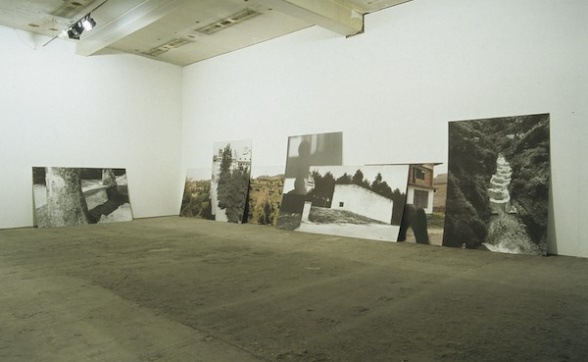Sophie Ristelhueber
Sophie Ristelhueber, La Campagne (series) (installation view), 1997
Sophie Ristelhueber (b. 1949, Lives and works in Paris, France) is concerned, first and foremost, with the ambivalence of things, the porous borderline between reality and fiction, the dialectical relationship between work and image, and the variable hierarchy of figures of speech, be it iconographic or linguistic speech: the said and the unsaid, more for less, part for whole.
One of the Sophie Ristelhueber’s pieces, La Campagne (The Countryside/The Campaign) produced in 1991-97, achieves a peak-like form in which the vectors of her particular arrangement all converge. For TRACE, It was made up of three groups of five to ten large photos stacked higgledy-piggledy against the wall at ground level. These black-and-white and colour photos were printed digitally, so as to achieve a simple poster-like rendering, and affixed to thin board right to the edges, in such a way as to convey the notion of temporariness and removability.
Vertical in format, some of them actually curved. At first glance, the overall impression was that of a stroll in rural surroundings, where the atmosphere is calm, even bucolic. The photos overlapped, so they were not all totally visible but we glimpsed here, a cart horse, there, a pine forest, and bathers in a waterfall nearby a picturesque village, and over there, a meadow dotted with dandelion flowers or alternatively a quite vertical view of a hillside planted with small trees, and, last of all, a country lane apparently cut off by a flooding river. However, in no time at all, the impression of tranquillity gave way to a vague sense of oppressiveness.
The perceptual interpretation, which wavers imperceptibly from the start, became blurred, slight signs of destruction appeared, and the frail interpretative scaffolding collapsed. We then see that the horse in the foreground was trotting in front of a deserted building whose windows had all been shattered, we realised that the dwellings nestling in the green field near the bathers, as well as the other dwellings in the other photos, were all destroyed and empty. Even without knowing that the village with the bathers is Mostar, that the flooded lane was due to the excavations following the discovery of a mass grave, that the dandelions were growing right beside a brand new cemetery, that the hill was the one the survivors of the Srebrenica massacre fled across, and that, in a word, the place was in ravaged Bosnia.
Sophie Ristelhueber at Liverpool Biennial 1999
La Campagne (series), 1997
22 digitised images printed on paper, mounted on cardboard
Courtesy of Galerie Arlogos, Paris
Liverpool Biennial
55 New Bird Street
Liverpool L1 0BW
- T +44 (0)151 709 7444
- info@biennial.com
Liverpool Biennial is funded by
Founding Supporter
James Moores
